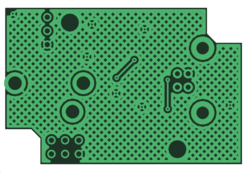
Copper pour
Encyclopedia


Printed circuit board
A printed circuit board, or PCB, is used to mechanically support and electrically connect electronic components using conductive pathways, tracks or signal traces etched from copper sheets laminated onto a non-conductive substrate. It is also referred to as printed wiring board or etched wiring...
filled with copper
Copper
Copper is a chemical element with the symbol Cu and atomic number 29. It is a ductile metal with very high thermal and electrical conductivity. Pure copper is soft and malleable; an exposed surface has a reddish-orange tarnish...
(the metal used to make connections in printed circuit boards). Copper pour is commonly used to create a ground plane
Ground plane
In electrical engineering, a ground plane is an electrically conductive surface.-Radio antenna theory :In telecommunication, a ground plane structure or relationship exists between the antenna and another object, where the only structure of the object is a structure which permits the antenna to...
. Another reason for using copper pour is to reduce the amount of etching fluid used during manufacturing.
A distinctive feature of copper pour is the backoff (or stand-off) - a certain distance between the copper pour and any tracks or pads not belonging to the same electrical net. A copper pour therefore looks like it flows around other components, with the exception of pads which are connected to the copper pour using thermal connections.
While solid copper pour provides better resistive characteristics,
hatched copper pour is used to balance the heat and dilatation on both sides of the board in order to avoid warping of certain substrate.
Heating might cause gas bubbles between solid copper pour and certain substrates.
Furthermore it might be possible to adjust the impedance of high frequency traces by using hatched copper pour in order to reach better signal quality.

